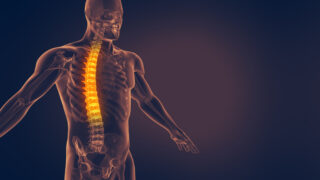
Center for Brain & Spine
SILVER SPRING CLINIC (MAIN)
1300 Spring Street
Suite 210
Silver Spring, MD 20910
301-585-7900
LAUREL CLINIC
UM Laurel Medical Center
7150 Contee Road, Suite 1C
Laurel, MD 20707
LARGO CLINIC
Advanced Medicine Building
9333 Healthcare Way Suite A-3-A-100
Largo, MD 20774
ROCKVILLE CLINIC
9905 Medical Center Dr.
Suite 330
Rockville, MD 20850
BOWIE CLINIC
14999 Health Center Drive
Suite 201
Bowie, MD 20716

More Pain Management & Rehabilitation Articles
Understanding Cervical Spine Disorders

Cervical spine disorders refer to medical conditions affecting the cervical vertebrae—the seven small bones that form the neck portion of the spine. These vertebrae support the head’s weight and allow for its movement. Unfortunately, these disorders can lead to a wide range of symptoms and significantly impact daily life. Understanding these conditions, their symptoms, and when to seek medical attention is crucial for effective management and treatment.
Common cervical spine disorders include:
- Cervical spondylosis: cartilage and vertebrae wear out abnormally
- Cervical herniated disc: discs between the vertebrae rupture, protrude, or bulge out
- Degenerative disc disease: discs between the vertebrae break down
- Cervical spinal stenosis: spinal canal narrows around the spinal cord
- Cervical myelopathy: spinal cord damage caused by stenosis or degeneration
- Cervical radiculopathy: pinched nerve or compression
Symptoms of cervical spine disorders may vary depending on the specific disorder but commonly include neck pain, stiffness, radiating pain, numbness or tingling, weakness, and headaches.
Neck pain can be persistent or intermittent, while stiffness can reduce flexibility and make it difficult to move the neck. Radiating pain may spread to the shoulders, arms, or hands. Numbness or tingling sensations are often felt in the arms and hands, and weakness can result in a loss of strength in these areas. Headaches usually originate from the neck base and spread forward.
It’s important to seek medical advice if you experience severe or persistent neck pain, pain that radiates into the shoulders or arms, numbness, tingling, or weakness in the arms or hands, difficulty with balance or coordination, or symptoms that do not improve with rest and over-the-counter pain medications.
Both nonsurgical treatment options and surgery are available to treat many of the conditions that affect the cervical spine. The choice depends on the cause and severity of the issue. If surgery is required, minimally invasive spine surgery can often be an option. Unlike traditional open surgery, which involves one large incision, minimally invasive surgery is performed through one or more smaller incisions. Working through smaller incisions causes much less damage to muscles and soft tissues than a single long incision.
Understanding cervical spine disorders and recognizing their symptoms are essential steps towards seeking appropriate treatment. Early consultation with an experienced neurosurgeon can lead to more effective management and better outcomes, allowing you to maintain a healthier, more active lifestyle.
Other Articles You May Find of Interest...
- Effective Strategies to Relieve Sore Knees and Alleviate Pain Fast
- Relieving Scapula Shoulder Blade Pain: Effective Strategies for Recovery
- Exploring the Causes and Remedies for Left Flank Pain in Women
- Can Back Pain Lead to Chest Pain? Understanding the Connection
- What Does Pain in Your Left Arm and Shoulder Mean?
- What Is DOMS and How Long Does Muscle Soreness Last?
- Navigating the Potential Side Effects of Enhertu: What Patients Should Know














